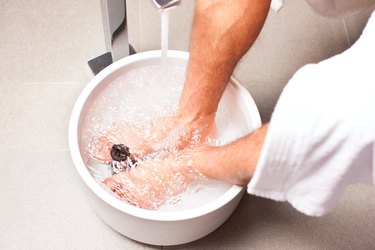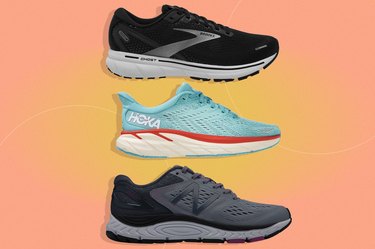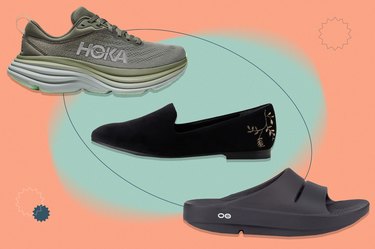
The signs of an ingrown toenail are telltale: tenderness, swelling and soreness. In a word: painful.
"An ingrown nail occurs when the skin on one or both sides of a nail grows over the edges of the nail, or when the nail itself grows into the skin," according to the American Academy of Orthopaedic Surgeons.
Video of the Day
Video of the Day
When your sharp toenail slices into the fleshy folds of your skin, searching for instant relief is understandably a top priority. And you can find a ton of home treatment options online that claim to cure ingrowns — like cutting a "v" in the middle of the tip of your nail, for example.
Here, podiatrists weigh in on this and other ingrown remedies, separating fact from fiction.
Should You Try the 'V' Method?
You might have heard that cutting a notch in the center of your toenail will temper the tendency for the nail to curve downward and dig into your skin. But does this method really minimize or heal ingrown toenails?
The answer is an unequivocal no. "The nail grows from the base (cuticle area) forward, so cutting a 'v' in the tip of the nail has no impact on growth," says Tracey C. Vlahovic, DPM, clinical professor at the Temple University School of Podiatric Medicine.
Nelya Lobkova, DPM, a New York City-based podiatrist at Step Up Footcare, agrees that this strategy falls short because the problem is at the corner of the toenail, not the center.
Other Home Remedies That Don’t Work
Don't waste your time on these ineffective techniques for ingrown toenails:
1. Placing Cotton or Dental Floss Under the Nail
This is only a temporary solution (for pain) that won't solve the underlying problem, Dr. Vlahovic says.
Dr. Lobkova also advises against using cotton in the corner of the nail because it can cause a separation of the nail plate (the hard part of the nail) from the nail bed, which may result in long-term damage to the toenail.
What's more, cotton can harbor harmful bacteria and lead to an infection, according to the American College of Foot and Ankle Surgeons.
2. Cutting the Corners of the Toenail
This strategy is unsafe, especially if a sharp nail edge remains, which can pierce the skin and cause a condition called paronychia (an infection of the skin surrounding the nail), Dr. Lobkova says.
It is safer to allow a physician to handle this procedure, if necessary.
Home Remedies That May Help

If your toenail isn't infected, you can safely try these at-home treatment options:
1. Tape the Skin
"For some of my patients with a milder situation who aren't looking to have nail surgery, I will have them tape the skin away from the nail border edge to encourage them to not abut," Dr. Vlahovic says.
To do this, place the tape on the skin where the ingrown is, then gently pull the tape to move the skin away from the nail. Wrap the tape around the bottom of the toe, then secure it over the cuticle. (For a visual, check out this graphic from AboutKidsHealth.)
While this is a temporary fix, it can provide immediate relief without risks of infection that come with cotton.
2. Soak in Epsom Salt
When you start to experience soreness in the corner of the toenail, soak it in warm water with Epsom salt twice per day, for 10 to15 minutes at a time. "The soaking will soften the nail and skin around it, alleviating pressure and preventing infection," Dr. Lobkova says.
After soaking, "it may also be beneficial to use a thin, narrow nail file to file the corner of the affected nail, which should decrease the pressure of the nail without creating a sharp edge that could break skin and cause infection," she adds.
When to See a Doctor
"If the soaking and filing is not effective in relieving pain, then I advise to have the ingrown toenail addressed by a podiatrist," Dr. Lobkova says.
Dr. Vlahovic agrees: "If it is a chronic, painful incurvated/ingrown nail, the best remedy is an in-office surgical procedure where the offending nail border is removed."
Always seek immediate medical attention if there's pus, redness and swelling, which often indicate an infection, Dr. Lobkova adds.
How to Prevent Ingrown Toenails

In most cases, it's totally possible to prevent this problem. Here are the top tips for inhibiting ingrown toenails, according to the American College of Foot and Ankle Surgeons:
1. Cut your nails correctly. Trim your toenails pretty much straight across. And don't cut them too short (think: nails should reach the edge of your toe). You can gently round the corners of the nails, but do not cut the corners much shorter than the skin itself. You also don't want to leave toenails too long, as the pressure from shoes can push the nails into the skin.
2. Avoid shoes that are too short or tight. The best footwear will have adequate room for your toes.
3. Avoid shoes that are too loose. Conversely, shoes that are too wide or roomy can also put pressure on the toes, especially during activities like running or brisk walking.
Tip
In some cases, toe spacers can help if pressure from other toes are also contributing to ingrown toenail formation or pain from an ingrown toenail.
Is this an emergency? If you are experiencing serious medical symptoms, please see the National Library of Medicine’s list of signs you need emergency medical attention or call 911.


